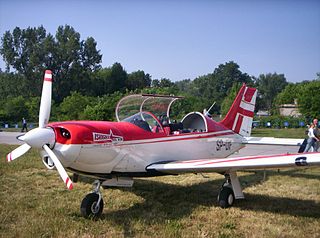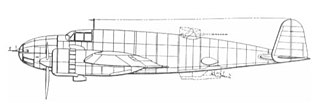
PZL was the largest Polish aerospace manufacturer of the interwar period, and a brand of their aircraft. Based in Warsaw between 1928 and 1939, PZL introduced a variety of well-regarded aircraft, most notably the PZL P.11 fighter, the PZL.23 Karaś light bomber, and the PZL.37 Łoś medium bomber.
RWD was a Polish aircraft construction bureau active between 1928 and 1939. It started as a team of three young designers, Stanisław Rogalski, Stanisław Wigura and Jerzy Drzewiecki, whose names formed the RWD acronym.

The PZL 130 Orlik is a Polish turboprop, single engine, two seat trainer aircraft.

PZL-104 Wilga is a Polish short-takeoff-and-landing (STOL) civil aviation utility aircraft designed and originally manufactured by PZL Warszawa-Okęcie, and later by European Aeronautic Defence and Space Company (EADS), who had acquired the original manufacturer during 2001.

The PZL-230 Skorpion (scorpion) was a proposed Polish low-cost attack aircraft. It was being developed by Polish manufacturer PZL Warszawa-Okecie in the late 1980s and early 1990s.

PZL.46 Sum (sheatfish) was a light bomber of the Polish Air Force before World War II, which, was directed to serial production in the spring of 1939. These planes were in production, but the Polish industry did not manage to produce them before the outbreak of the war.

The PZL-101 Gawron (rook) is a Polish agricultural and utility aircraft designed and built by WSK-Okęcie.

The PZL.38 Wilk (wolf) (PZL-38) was a Polish heavy fighter developed and manufactured by PZL state factory in 1937. Intended for use primarily as a fighter-bomber, the Polish Air Force also envisioned it replacing light fighters in long-range operations, along with being able to serve as a light bomber. Only two examples were built before the project was cancelled in favor of a planned improved variant, the PZL.48 Lampart.

The PWS-33 Wyżeł was a Polish twin-engined military trainer aircraft from a period before World War II constructed by Podlaska Wytwórnia Samolotów or PWS. Although destined for production it got no further than the prototypes before Poland was invaded.

PZL M26 Iskierka or M26 Airwolf is a Polish trainer and aerobatic aircraft, designed at WSK PZL-Mielec.

Tadeusz Chylińnski – was a Polish airplane designer and constructor, a researcher at the Institute of Aviation in Warsaw and specialist in aircraft structures.

The PZL-106 Kruk is a Polish agricultural aircraft designed and built by WSK PZL Warszawa-Okęcie.

The PZL-105 Flaming (flamingo) is a Polish short-takeoff-and-landing (STOL) utility aircraft designed by PZL "Warszawa-Okęcie". It remained a prototype.

The PZL.43 was a Polish light bomber and reconnaissance aircraft designed in the mid-1930s by PZL in Warsaw. It was an export development of the PZL.23 Karaś. Its main user was the Bulgarian Airforce who called it the Chaika.

PZL.12 (PZL-H) was a prototype of a Polish amphibious flying boat designed and built in 1931 by Zygmunt Puławski, a pioneering Polish designer. He was killed in a crash involving this design.

The PZL P.1 was a Polish fighter, designed by the engineer Zygmunt Puławski, manufactured by the PZL state-owned factory. It remained a prototype, but it was the first of the Polish PZL gull wing fighter series, leading to the PZL P.7, PZL P.11 and PZL P.24.

The PZL.49 Miś was a Polish twin-engined medium bomber design that remained only a project due to the outbreak of World War II. The PZL.49 was based on the contemporary PZL.37 Łoś and was to replace it at production lines at the PZL works.

The PZL-126 Mrówka (ant) is a Polish agricultural aircraft first flown in 1990. It is a diminutive low-wing monoplane of conventional if stubby appearance with a cruciform tail, an enclosed cabin and fixed, tricycle undercarriage. Significant parts of the design were undertaken by students at the training college attached to the PZL plant at Okęcie under the direction of Andrzej Słocinski, with the whole project treated initially as a platform for design innovation. Initial design work was completed in 1982 and detail work the following year. Plans to fly a prototype by 1985 were delayed by revisions to the aircraft's equipment, although a mockup was displayed at an agricultural aviation exhibition at Olsztyn that August. Legislation to outlaw certain agricultural chemicals was under consideration in Poland in the late 1980s, spurring interest in biological agents as an alternative and making a tiny aircraft like the Mrówka feasible as a useful piece of agricultural equipment.
The RWD 18 was a four/five seat STOL utility aircraft designed and built in Poland from 1936.

The PZL SM-4 Łątka was a prototype three-seat helicopter of the 1960s, developed by WSK PZL-Świdnik in Poland. Of largely conventional design and construction, a single prototype was built, but was not flown as a result of engine problems.


















